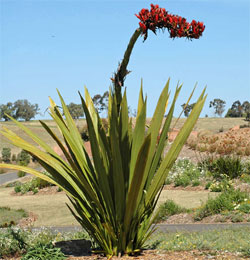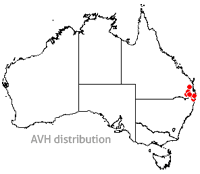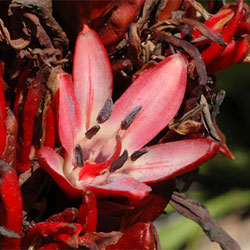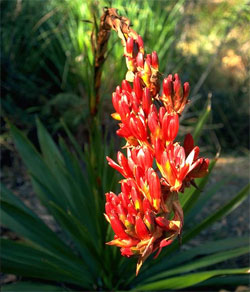Doryanthes palmeri
 |
Giant Spear Lily
 Doryanthes palmeri, commonly called the giant spear lily,is a hardy, low maintenance monocot endemic to north east New South Wales and south east Queensland. It is listed as vulnerable due to the fact that it occurs in so few regions of Australia.
Doryanthes palmeri, commonly called the giant spear lily,is a hardy, low maintenance monocot endemic to north east New South Wales and south east Queensland. It is listed as vulnerable due to the fact that it occurs in so few regions of Australia.
It was thought to belong to the Agavaceae family until genetic evidence showed that it is younger than the agaves. Therefore it was given its own family, Doryanthaceae.
It can grow to three metres tall and four metres wide. It has long sword-like leaves which form in rosettes and are ribbed to provide structural support.
It has a flowering stalk, called a scape, which can grow to five metres tall. Unlike the other species in this genus (Doryanthes excelsa) the Doryanthes palmeri stalk droops rather than standing upright due to the weight of the flowers. Individual flowers are red or reddish-orange and are up to 10 cm in diameter. It is pollinated by birds, which are attracted to its bright red flowers. The fruit is egg-shaped and 7- 9 cm long.
Each rosette flowers once in its lifetime, but after flowering, the plant is able to produce more rosettes. Doryanthes palmeri flowers in spring but can take over 13 years to flower. Flowering can be brought on by bushfires, which also promotes the sprouting of root bulbs. In a garden flowering can be encouraged by ensuring that the plant is grown in full sun.
Roasted Doryanthes flower spikes were used as a food source for Indigenous Australians and the roots were mashed into a pulp and made into cakes.
The two Doryanthes species are xerophytes, meaning that they have adapted to dry conditions and do not require much water. However, leaves can yellow in heat over 40 degrees. It can be grown in indoor pots; however the leaves may droop if the plant isn't in full sun. The plant requires little maintenance however it is best to cut off dying leaves and flower spikes.
It is suited to most soil types, including nutrient deficient soils but will be more successful if some fertiliser is added. D. palmeri will thrive in many different climates including windy environments due to the structural support provided by the ribbing in the leaves.
Plants can be propagated by division or by seed. Seed germination can be encouraged by fire or can be assisted with the use of commercial products such as smoke water. Soaking seeds in water for eight hours before planting may also assist in germination.
While the plant requires little maintenance, it would only be suited to a large backyard or garden due to the width of the rosettes.
Text by Laurel Fowler (2012 Student Botanical Intern)
Name Meaning: Doryanthes palmeriDoryanthes — from two Greek words; doratos meaning spear and anthos which means flower. palmeri — derivation not stated by the original author of the name but given in subsequent references as honouring Sir Arthur Hunter Palmer (1819-1898), Premier of Queensland (1870-1874). |
References
Department of Environment and Conservation (2011) Doryanthes palmeri (giant rosette plant) - vulnerable species listing. Available at http://www.environment.nsw.gov.au/determinations/DoryanthesPalmeriGiantRosettePlantVulSpListing.htm [Accessed March 2012].
Dimech, A. (2011) Monocotyledons. Plant Evolution. Available at http://www.adonline.id.au/plantevol/tour/monocotyledons/ [Accessed Feb 2012].
Eggli, U. & Newton, L.E. (2004) Etymological Dictionary of Succulent Plant Names. Birkhauser Publishing.
Kapitany, A. (2011). Australian Gymea and Spear Lilies. (The Australian Series Vol. 3), Boronia, Vic.
Pacific Bulb Society (2011) Doryanthes. Viewed at http://www.pacificbulbsociety.org/pbswiki/index.php/Doryanthes [Accessed Feb 2012].
Perry, D.A. (2001) The distribution, relative abundance and conservation status of Doryanthes palmeri (Doryanthaceae) in New South Wales.Cunninghamia 7(2): 183-193.
Rymer, J. (2006) Doryanthes excelsa. Australian National Botanic Gardens. Viewed at http://www.anbg.gov.au/gnp/gnp12/doryanthes-excelsa.html [Accessed Feb 2012].
![An Australian Government Initiative [logo]](/images/austgovt_brown_90px.gif)



